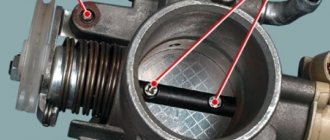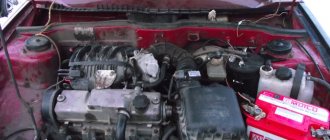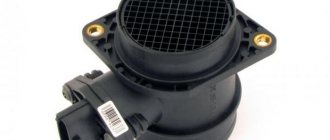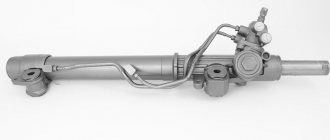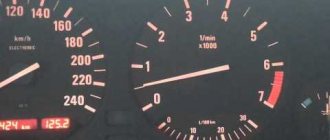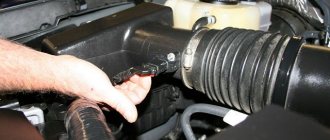Sooner or later, almost any driver will definitely encounter such a problem. When the idle speed fluctuates, it is quite difficult to operate the car. At a traffic light, it may stall or fail on a descent using neutral gear. From time to time you have to “help” the engine by pressing the gas pedal to prevent the car from stalling. The tachometer needle now and then shows different revolutions (from 500 to 1200). In addition, engine shaking bothers the driver and passengers, and low speed significantly reduces engine life. Today you will learn about the most common causes of unstable engine idling and ways to eliminate this problem.
A successful solution to this difficult problem is absolutely impossible without making a correct “diagnosis”, and, therefore, the car enthusiast should be well aware of the full list of “symptoms” indicating incorrect carburetor operation:
- Independent drop and rise in engine speed.
- Misfires in cylinder operation.
- The occurrence of sharp “pops” in the area of the carburetor or muffler.
- Unstable engine speed in idle mode.
Reasons for instability of the VAZ 2109 (21099) carburetor
A clear indication of the relevance of the problem, characterized by instability of engine speed in idle mode, is the frequent mention of it in special printed publications and Internet forums. There is a particularly wide discussion of this issue among owners of domestic VAZ 2109 and VAZ 21099. In the article brought to your attention, we propose to consider the reasons that contribute to the situation in which the VAZ 21099 (carburetor) has floating speed, as well as ways and means of eliminating them (the causes).
The main reasons that cause failures in the operation of the power unit in the VAZ 2109 (carburetor) are:
- Incorrect carburetor adjustment . As a rule, the position of the screws that regulate the “quality” of the mixture ensures that a “lean” combustible mixture is supplied to the system. The solution is to adjust the carburetor, the detailed technology for which will be discussed below.
- Malfunction of the solenoid valve with the control unit, which stops the fuel supply when the crankshaft reaches 2100 rpm and resumes it (supply) when the speed drops to 1900. The functionality is checked by quickly removing and putting the wire on the valve while the engine is running. A click made by the valve indicates that it is in good condition.
- Contamination of the jets and channels of the idle system . It can be eliminated using a special cleaner followed by blowing with compressed air.
- Excess air entering the fuel mixture as a result of leakage of connections. First of all, this concerns the integrity of the pipe connecting the vacuum brake booster to the intake manifold.
- Malfunction of the needle valve , causing an increase (decrease) in the fuel level in the float chamber. In some cases, the problem can be solved by cleaning the valve, but the vast majority of experts recommend replacing a sticky needle valve with a new one.
Optional equipment
As a rule, the stable engine speed of most cars is affected by turning on the air conditioning compressor. Very often this happens at low and idle speeds. Since the air conditioner consumes a considerable amount of energy, the control unit sends a signal to the power system to increase the volume of fuel mixture supplied to increase idle speed to compensate for the loss of power consumed by the air conditioner.
But when the impulse to turn on the air conditioner does not arrive at the electronic unit due to a communication failure between the computer and the device module, the control unit is not able to assess the situation and add fuel. As a result, the stability of idle speed is disrupted until the moment when the engine completely stalls.
Video - Why the engine speed fluctuates at idle
The occurrence of the above malfunctions is a consequence of violations of the operating conditions defined by the manufacturer, or the negative impact of external climatic factors: high humidity, abnormally high (low) temperature values or its sharp fluctuations.
In addition, it must be taken into account that the reason for the incorrect functioning of the “nine” carburetor may be a malfunction of the vehicle’s power system, ignition system, or a clogged air filter.
Depending on the type of VAZ engine, there are different types of reasons. Let's start with carburetor cars of Soviet and Russian production VAZ 2107 and VAZ 2109.
In a situation where the reason that the VAZ 21099 (carburetor) has variable speed is due to incorrect adjustment, the vast majority of car enthusiasts, especially those with little practical experience, prefer to use the services of professional auto mechanics. However, you can perform this operation yourself, using the instructions presented below. As an example, let's look at the technology for adjusting the idle speed of the Solex carburetor, which is the most common on the VAZ 2109 and VAZ 21099 models.
The objects of adjustment are the screws that regulate the “quantity” (Figure 1, position 1) and “quality” (Figure 1, position 2) of the combustible mixture, and the working tool is a screwdriver with a flat blade and an external tachometer, which makes it easy to take readings.
Picture 1
How does a brake light work?
In order to set up a brake light that lights up at the right time on the bumper, you must first understand how the system for supplying information from the brake pedal of the VAZ-2114 works. Without the necessary knowledge, you don’t even need to start doing everything manually, because most likely the driver won’t succeed.
When the driver presses the brake pedal, the brake light comes on. From it, voltage is supplied through all the necessary wiring to the device for dividing the same current, from where it is supplied to the analog input. After this, 14 digital pins are activated thanks to specially tuned pulses.
They are connected to the corresponding keys so that the glow power increases if the LED bulbs have 1 Watt, after which the load on the microcontroller is reduced. The output shows that the brake light LEDs of the VAZ-2114 spoiler are connected to a transistor circuit; after all operations they become active.
The power of the LEDs doesn't really matter. It is important to remember that in order for the brake light to be correctly displayed in the spoiler and visible to the driver driving behind, it is not necessary to install high power bulbs; 1 W will be quite enough.
Adjusting the idle speed on a VAZ carburetor engine
The fact is that when much more air enters the carburetor than gasoline, the mixture becomes lean. Fuel burns in small quantities in the cylinders, and accordingly, appropriate pressure does not arise in the combustion chamber, and therefore the engine begins to stall. Such settings are lost during long-term use of the car. It is enough to simply unscrew the idle speed bolt a little and the speed will immediately level out.
The second point is that the mixture is too rich, when much more gasoline is supplied than fuel. Typically, this is evidenced by characteristic shooting in the muffler (unburned gasoline ignites in the exhaust system) when you try to press the gas pedal and equalize the speed. In most cases, the engine stalls, and starting it after this becomes a real problem. In this case, it is necessary to carry out a more serious adjustment of the carburetor, namely, tighten all the bolts until they stop and unscrew them in accordance with the instruction manual. The fuel mixture should equalize and the engine will begin to successfully maintain idle speed.
Another malfunction is typical for modern carburetors equipped with a solenoid valve. This device has been trembling the nerves of many car owners for a long time due to its incorrect operation. The fact is that poor contact on the valve can seriously affect the speed stability and the car can only be operated on choke.
First of all, you need to check the tightness of the valve and tighten it if it accidentally gets loose. The solenoid valve wire must be intact and the contact connection must be sufficiently clean. If all else fails, try turning the ignition on and off; the valve should make a characteristic clicking sound. If this does not happen, replace it.
- Adjusting the float chamber can also affect the operation of the unit. Start the engine and turn it off, then check the gasoline level in the chamber. In normal condition, the float chamber should only be half full of gasoline. If this is not the case, then bend the float lever in the appropriate direction, assemble the carburetor and repeat the procedure until you reach the normalized values.
If the above instructions do not help, then it’s time to think about cleaning and repairing the carburetor. To save on purchasing a repair kit, you can completely disassemble the unit and immerse all its working parts in acetone. After this, you need to thoroughly wipe it with a dry cloth, and clean the jets with a thin object. If possible, check the size of the jets installed on your carburetor. If they do not meet the standards, then the jets must be replaced. Now assemble the carburetor and adjust it.
So let's get started:
- The list of preparatory measures includes checking the correct installation of the ignition and warming up the car engine to a temperature of 900C.
- We take tachometer readings.
- Using a screwdriver, we begin the adjustment.
Attention! To make it easier to count screw revolutions, place a mark on the handle of the screwdriver.
- Turn screw No. 1 clockwise until it stops. The car engine should stall because the supply of the fuel mixture is stopped. We make two revolutions in the opposite direction and start the power plant. If the start does not occur, make another turn of screw No. 1 in the same direction.
- Next, unscrew the screw until the crankshaft speed stops increasing, after which we unscrew the screw one more turn. Using an external tachometer we control the number of revolutions. If it remains unchanged, we return the propeller to the point where the engine speed stops growing, that is, by one revolution of the propeller.
- The tachometer reading should not exceed 1020 rpm. If this is not the case, then it becomes necessary to repeatedly manipulate screw No. 1, which regulates the “quality” of the fuel mixture. Rotating the screw counterclockwise reduces the speed.
- Having set the engine speed at 1020 rpm, we begin manipulating screw No. 2, which regulates the “quality” of the fuel mixture. By rotating it clockwise, we achieve a reduction in the number of crankshaft revolutions to 850 rpm.
Attention! This speed indicator in idle mode will only be maintained when the power unit is warmed up. Therefore, for car enthusiasts who are not accustomed to prolonged “warming up” of the engine, we recommend increasing this figure to 900 rpm.
In conclusion, we present two methods that allow you to normalize engine speed in the “idle” mode in the absence of the desire or ability to perform the adjustment operations described above.
- As a rule, when using domestic AI-92 gasoline, the ignition is set to +40. Having unscrewed the “quality” screw four turns, we set the “idle speed” speed to “speed”.
- Fans of “quick start” and adherents of AI-95 gasoline often set the ignition timing to +60. In this case, release the screw that regulates the quality of the combustible mixture by five turns.
These simple settings, of course, are not a panacea in a situation where in a VAZ 2019 car (carburetor) failures and instability of speed are an everyday reality. However, they are able to partially solve the problem under circumstances that are not conducive to carrying out the regulatory process.
Troubleshooting
In order to fix this problem, you need to determine the culprit. Once you have located the location where the problem occurred, you can begin preparing for the repair work. First of all, check whether the carburetor is set correctly. To do this, tighten the quality screw and the quantity screw until it stops, and then unscrew it as indicated in the factory settings of the carburetor (often, the carburetor settings are as follows: quality screw - 2.5 turns, quantity screw - 4 turns). If there are no changes, and the engine still does not idle, or even stalls, then you need to look for the reason, choosing from the above.
XX speed floats on VAZ injector
There are various reasons for this, such as improper operation of the controller and operation of the injectors. To know exactly the nature of the malfunction, the easiest way is to conduct electronic diagnostics of all systems and determine the cause of the malfunction using the error code. This list may include the following items.
- The injector is very dirty or leaking . Injector contamination occurs when low-quality fuel is used or the engine is driven to fuel starvation, when the gasoline pump pumps not gasoline, but its residues at the bottom of the fuel tank. In this case, special additives are used that clean the part during engine operation.
If the injectors are leaking, they must be replaced. This is due to the deterioration of the quality of the sealing gaskets installed inside the element, which violates the tightness of the system and allows excessive amounts of fuel to enter the combustion chamber.
Attention! Leaking injectors can overfill the fuel chamber and cause increased pressure in the cylinder (water hammer). This phenomenon can negatively affect the internal parts of the engine.
Another problem may affect the idle speed sensor (regulator), which fails and gives the wrong command to the crankshaft speed. As a result, the engine runs intermittently and may even stall. By the way, the idle speed sensor is not the only electrical device that affects the stability of the engine. Among others, we can note the mass air flow sensor and many other devices, information from which is no longer sent to the ECU. The controller, without the necessary information, can put the engine into emergency mode (Check Engine).
Checking the fuel pump
The main indicator of the performance of the fuel pump is the gasoline pressure in the fuel rail. Methods of connecting to the fuel line:
- using a standard fitting to measure pressure in the rail. This type of power system is installed on VAZ 8-valve internal combustion engines with a fuel return line from the rack to the gas tank. You can connect the pressure gauge through an adapter that screws onto a fitting with an external thread. Inside the fitting there is a spool valve, reminiscent of a bicycle valve, which, when pressed, communicates with the fuel rail and pressure gauge hose. But not all cars have a factory connector for connecting a pressure gauge. And in some cases the adapter itself is more difficult to find than to make a device for direct connection;
- connection contrary to the fuel line. You will need: a pressure gauge with a measurement scale of up to 7 kg/cm², a fuel hose of a suitable diameter, a tee and 2 fittings (“male” and “female” quick-release type) for connecting standard pipes. Such a simple device will allow you to crash into the fuel line, while maintaining the ability to start the engine.
There are a large number of ready-made kits for measuring fuel pressure in the rail on sale. But purchasing it is not practical for one-time use. The high cost is due to the many different fittings and adapters for connecting to the main types of power systems. If you are considering purchasing such a kit, make sure that it has the necessary adapters to connect to your car.
Problems common to both engine types
These malfunctions can be attributed to both injection and carburetor engines, since they occur on both power plants.
- Dirty air filter . If the air purification filter is sufficiently dirty, then air begins to flow in rather small quantities, which leads to oxygen starvation. In this case, it is necessary to replace the filter element and continue to operate the vehicle.
- Ignition system malfunction . First of all, check for the presence of a spark on the high-voltage wires and spark plugs. This requires two people. The first turns the engine using the starter, and the second checks for the presence of a spark. The spark plug is unscrewed and reinserted into the wire. A partner leans the end of the spark plug against the cylinder block at a distance of approximately 5-10 millimeters. If a spark does not appear while the engine is rotating, you need to check the serviceability of the spark plug or armor wire. The absence of a spark on all spark plugs and armor wires indicates a malfunction of the ignition module or coil. The element is replaced, and the spark plugs are cleaned of any deposits that have appeared.
If there was no spark, then the armored wire is not leaned against the cylinder head, but against the spark plug itself, screwed to the block. If a spark appears, then we can say with confidence that the spark plug is faulty.
Attention! When checking the spark, you should not hold onto the body of the car, as you may receive an electric shock of 40 thousand volts. This voltage is not lethal at low current strength, but there is nothing pleasant about it. Also, do not use prolonged sparking as there is a chance of damaging the ignition module or the coil winding insulation.
It is worth noting that the absence of a spark on all spark plugs is accompanied by the absence of signs of engine life, that is, it does not start at all. Therefore, most often, one spark plug or wire fails, which is immediately replaced. Although it is true that even if all spark plugs are in good working order, they still work unstably on your engine. You can try to fix the problem by replacing parts.
- Fuel filter is dirty . It occurs during long-term use of the car, when there are fewer and fewer holes in the filter and the engine performs worse each time. The fuel filter is being replaced.
These are, perhaps, all the reasons why idle speed may fluctuate. As you can see, their diagnosis and elimination methods will not cause any particular difficulties, so this procedure can be performed with your own hands, without the help of car service employees.
Features of this tuning
The brake light in the spoiler has a number of advantages:
- It's stylish, that's why they buy spoilers. Without a spoiler, the VAZ looks like a simple classic car, even a kind of retro, but with a spoiler it looks quite original.
- The spoiler best conveys the stop signal, and you can come up with any animation that attracts attention, but you need to be careful with this.
- The spoiler has a low price, and almost every driver can install it independently.
- The spoiler is installed once for many years, so it is beautiful and profitable.
- The brake light on the spoiler is more visible, so even from a road safety standpoint, the spoiler wins.
Although the spoiler is a decoration of the car, it is difficult to say why it is installed on the VAZ. Most likely, this is due to the fact that the car of the classic brand looks modernized and stylish compared to the standard version.
Those drivers who want to figure out how to do all this on their own need to first understand the essence of how microcircuits work, because they are one of the main parts designed to provide information, without which the operation would simply be impossible. It also wouldn’t hurt for the driver to read about the wing in specialized literature.
In order to organize your own installation of a spoiler, you need to purchase a printed circuit board, mounting drills, ferric chloride and the required number of LED lamps (usually no more than 16) from a radio parts store. The printed circuit board is manufactured only according to the diagram.
In conclusion, we can say that the process of installing a brake light on a VAZ-2114 spoiler is simple. The main thing is to get the desired result and be able to use it correctly. Not all drivers use the brake light in their car correctly.
It is important to note that the spoiler requires special attention and the brake light on it is not as easy to operate as it seems. It is necessary to remember the principle of operation of the LEDs on the brake light and control the glow of the bulbs, because the spoiler lights up exactly the way the driver wants. Accordingly, it depends on the driver himself whether there will be a traffic accident or not. Have a good trip!
Initially, the rear brake lights did not light up. They only burned on the spoiler. Moreover, when the ignition was turned on, the spoiler barely glowed. Many opinions were expressed to me on this matter. As a result, I replaced the relay for monitoring burnt out lamps - 130 rubles. down the drain... Next I checked the wiring, but it’s very damp under the carpet, but the wiring is intact, not rotten, therefore it’s not shorting anything. Then the frog was checked, and the spoiler was also on. Then I cleaned the mass of the flashlight, and the mass on the body from the battery. The result is that when ignited, the spoiler burns a little brighter)))
The day before yesterday I decided to do this - the spoiler is on, which means current flows to it when braking. I connect the wire from the spoiler and directly to the flashlight - zero effect. There is current. This means there are problems with contacts. They are clean, which means the pay is ok. Today I bought a new board (I took one to start with).
We measure the pressure with our own hands
Before connecting to the fuel line, it is necessary to relieve the residual pressure in the system. To do this, just pull out the fuel pump fuse with the engine running. When the engine stalls, you can return the fuse and get to work. Let's move on to methods for measuring fuel pressure in the rail.
- Measurement with ignition on. The pressure gauge needle should rise rapidly and freeze in the normal pressure range. If after turning off the ignition arrow the pressure drops rapidly, the RTD on your car is faulty.
- Measurement with the engine running. The pressure gauge needle should not twitch or show less pressure than the lower limit of the standard values.
- Measurement with the ignition on and the return line pinched. In this case, the pump presses “against the wall” as much as possible.
If your car stalls when cold when you press the gas, perform diagnostics on a cold engine
It is important to simulate the conditions under which the symptoms of a malfunction appear most often
